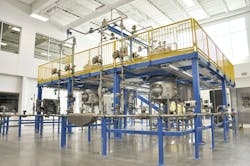Dan Hebert is a former senior technical editor for Control, Control Design and Industrial Networking.
- Paced by student
- Delivered on-demand to fit student schedule
- No need to wait for scheduled course
- Quicker, no time wasted traveling to classroom
- Cheaper for student, no travel expenses
- Cheaper for provider, no classroom needed
- Easy to provide videos and other visual training aids
- Can be revisited as needed
- Prepares students for more in-depth instruction
- Familiar learning method for younger students
- Can closely simulate the real world
- More interesting for students
- Allows for in-depth instruction
- Minimizes required training on the actual system
- Expensive to provide
- Travel required for students
- Very time-consuming
Don’t we all remember dreary days spent in a classroom listening to a teacher drone on and on? Perhaps the main cause of your boredom was that the instructor was teaching at the pace of the slowest student. Or maybe you couldn’t make the connection between the theory of the classroom and practice in your life. In light of these issues, new methods of instruction, chief among them online and hands-on training, have gained favor.
Online training has many advantages over classroom instruction, chief among them the ability of the student to move along at a preferred pace (Table 1). No more waiting for the instructor to explain the basics to newbies while advanced students struggle to stay awake, as online courses are paced by the student.
Hands-on training goes more in-depth and confers advantages that online instruction can’t, but has its challenges (Table 2). The main selling point for hands-on training is that it does what no other training can: closely simulate the real world.
Online Instruction
Online training continues to grow in popularity from college campuses to corporate environments.
Automation professionals are joining the online party. “I’ve taken advantage of some amazing free online lectures from MIT and find them to be of great benefit,” says Laurence Durack, lead electrical engineer at Electroimpact in Mukilteo, Wash. “In some ways they are better than sitting in class as you can stop and repeat any points you miss. I can see a transformation of the whole education process with tools such as this, and I feel the existing approach is ripe for overhaul.”
Electroimpact builds complete automation assembly systems for commercial aircraft wings, riveting machines and tools for wing panel and fuselage assembly, advanced fiber placement machines, robotic assembly systems and spacecraft transportation equipment (Figure 1).
Learn More: How to Combat a Lack of Fundamentals in EE Degree Training
Scott Hendrickson, CEO of Olympus Controls, a systems integrator serving machine builders from its base in Seattle, also sees the value of online instruction. “We’ve looked at online training programs through a company called BlueVolt, which delivers a Web-based learning management system. Its cloud-based platform delivers professional training programs on just about any machine automation technology.”
Randy Ransom, director of training at Intelligrated, a material handling OEM in Mason, Ohio, has an interesting approach to e-learning. “Requiring students to complete online e-learning training modules prior to an instructor-led session provides a baseline of knowledge for all students,” he explains. “This allows the instructor to begin training at a deeper level since the basic concepts and terminology have already been covered. Students also tend to ask more probing questions during the instructor-led training sessions when they’ve been exposed to the initial e-learning training.”
Figure 1: Electroimpact’s Automated Fiber Placement technology is used to lay up fuselage panels for the Airbus A350 aircraft at Spirit Aerostructures in Kinston, North Carolina. The advanced controls and process head technology on this machine allows cutting and adding within customer end placement tolerances at rates up to 1600 in/min over ramped, complex surfaces.
Online courses can even supply students with virtual hands-on equipment. Delta Computer Systems provides two-day live online training courses that are fully interactive with an actual Delta RMC motion controller for each student, accessed via the Internet.
“The hands-on, instructor-led training covers setup, tuning, programming and diagnostics of RMC motion controllers for closed-loop position and velocity control through a series of lessons and lab exercises,” explains Bill Savela, marketing director at Delta. “Closed-loop motion control is a new concept to many hydraulic engineers, and Delta has found that by giving students hands-on experience they can complete their machine development much more quickly and with fewer support requirements.”
Phoenix Contact offers free virtual classes every month for different technologies, with sessions lasting between one and four hours. “Virtual training gives us increased flexibility by enabling us to involve various specialists as required for each topic,” explains Matt Varano, solution engineer at Phoenix Contact. “It also allows us the ability to schedule training over multiple sessions at the convenience of the customer.”
But e-learning isn’t universally accepted or subject to any standards. Online training ranges from 30-second videos to hour-long sessions, and prices range from free to thousands of dollars.
All Hands on Deck
Figure 2: Perhaps the industry’s most elaborate process training unit, this Endress+Hauser PTU contains a wide variety of equipment, instruments and automation components.
Classroom training supplemented with hands-on instruction is gaining in popularity because it can closely simulate actual automation system operation. Endress+Hauser conducts classroom training at several locations across the country, using process training units (PTUs), which closely mimic operations process skids (Figure 2).
“A process training unit is a mini process plant that allows the instruments to perform in a real-world environment,” explains Jerry Spindler, training manager at E+H. “This allows a higher level of training with instruments in an actual installation very similar to what they have in their own plant. They can simulate process problems, perform troubleshooting and show integration into the PLC.”
Demand for E+H training has increased as process skid OEMs and others realize its value. “We’ve put three more PTU locations in the United States this year,” reports Spindler. “Now we are up to 10 locations total, with more planned in 2015.”
Joseph W. Snyder, president of Process and Data Automation, a systems integrator in Erie, Penn., builds its own mini PTUs to provide hands-on experience.
Learn More: Build Your Own Training Units
“While there are options to purchase off-the shelf configured trainers, we typically use internally constructed systems,” says Snyder. “Building these systems ourselves also allows us to use the entire specification-and-build process of new process skids as an internal training course in project management.”
Nick Stephens, managing director for 22solutions, a systems integrator in Ballarat, Australia, says hands-on training works best when employees can be counted on to stay with the company. “We believe hands-on training is most effective if the staff attrition rate is low,” he explains. “With a low attrition rate we generally find the users have been working with similar products so they understand processes and the system. People like this type of one-on-one training as it feels more personal to them to see someone in the flesh who designed or created the system they are about to take responsibility for.”
Classroom Best Practices
And then there are the good old-fashioned classroom sessions, held either at the customer’s offices or at the vendor’s training facility. Just about every equipment vendor offers classroom training, and many OEMs take advantage.
“We rely on many of our supplier partners to train our new hires on their specific technology,” says Olympus’ Hendrickson, who uses training from Parker Hannifin. “Parker’s comprehensive six-week program provides new hires with an excellent understanding of the technologies that are the foundation for the automation industry. Parker Hannifin was one of the first companies in the motion control industry to establish an intensive immersion program for new college graduates. The highlight of the training program is the final project week, where students are broken up into teams and assigned projects that tie the six weeks of training into a final test of imagination and creativity requiring mechanical, electrical and software skills.”
On-site training remains popular, too. “On-site remains the most popular type of training, since our service techs are often already at the site helping with startup and commissioning,” says Spindler. “They just go ahead and provide some basic classroom instruction and on-the-job guidance, if requested.”
Learn More: Innovation That Boils and Burns
In an innovative take on classroom instruction, Phoenix Contact offers a hands-on virtual on-site training experience from a customer’s location by providing remote access to physical control hardware at the company’s Middletown, Pennsylvania location. This approach combines the best of classroom instruction and hands-on training by adding an online component.
Many organizations offer online, classroom and hands-on training, or combinations thereof. Carl Henning, deputy director of PI North America, says the organization offers 30-to-60-minute webinars, free Profinet one-day training classes, Profitelevision with video how-tos and one-minute discussions on YouTube.
“MinuteProfinet is the most popular with 5,000 views per month,” notes Henning. “One-day training classes are held in at least 16 North American cities per year, and attendance has risen every year.”
Conclusion
One problem seems to be a lack of standardization, but some steps are being taken to address this issue. Olympus’ Hendrickson says, “Two of the main trade associations for the automation industry, the Motion Control Association and the Association for High Technology Distribution, are developing training programs to introduce new hires to technology fundamentals.”
Ben Furnish, division marketing manager at Parker Hannifin, adds, “The Packaging Machinery Manufacturers Institute and its Alliance for Innovation & Operational Excellence are teaming up to develop a curriculum for training workers in the automation field.”







